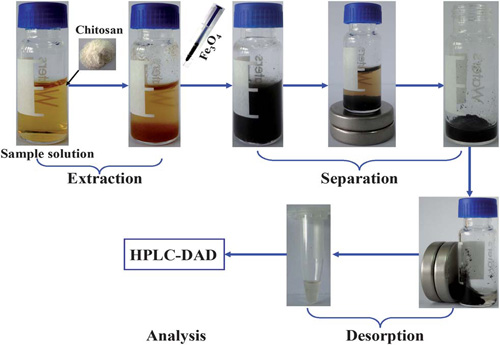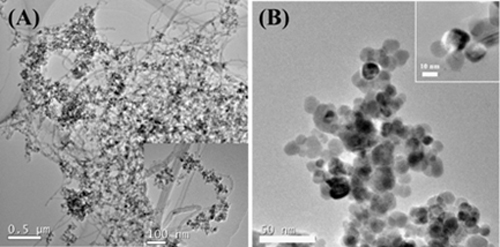Since its establishment in 1974, magnetic carrier technology (MCT) has been widely used in bioseparation. As a commonly used magnetic carrier, Fe3O4 can be modified as magnetic nucleus to be used in the extraction of target analytes.
Researchers from the Key Laboratory of Chemistry of Northwestern Plant Resources, Chinese Academy of Sciences, have been engaged in the research on new materials and methods for MCT for years, aiming to establish fast, highly efficient and environmental-friendly extraction methods.
First, they have developed a solid-phase extraction (SPE) method using mixed hemimicelles and high-performance liquid chromatography-diode array detection (HPLC-DAD) (Figure 2B) for the pre-concentration and determination of anthraquinones (AQs), active ingredients in Radix et Rhizoma Rhei. The mixed hemimicelles were synthesized by coating cetyltrimethylammonium bromide (CTAB) on Fe3O4 nanoparticles. The method has some advantages, including rapid separation, low cost, convenient utilization, and environmental benignity.
Since flavonoids in green tea beverage samples have multiple pharmacological effects, researchers have developed a new SPE mode for magnetic retrieval of chitosan combined with HPLC-DAD for their pre-concentration and determination (For extraction process, see Figure 1). In this mode, chitosan was directly put into acidic sample solution as sorbents for the extraction of target analytes. A great deal of undissolved chitosan in the sample solution plays an important role for extraction. After the completion of the extraction process, Fe3O4 nanoparticles acting as carrier were added to retrieve chitosan from sample solution. Good reproducibilities and satisfactory recoveries were obtained.
Based on the above research, researchers have prepared a magnetic carbon nanomaterial for Fe3O4 enclosure hydroxylated multi-walled carbon nanotubes (Fe3O4-EC-MWCNTs-OH) (Figure 2A) by the aggregating effect of Fe3O4 nanoparticle on MWCNTs-OH. Then they have combined it with HPLC-DAD to determine the aconitines (aconitine, hypaconitine and mesaconitine) in human serum samples.
The new methods developed by researchers all possess the advantages of fastness, simplicity, low cost, ease of operation and environmental benignity. They can be applied in pre-concentration and determination of Traditional Chinese Medicine (TCM) constituents, biological medicine science and technology, etc.
The above work has received support from the National Natural Science Foundation of China. The findings have been published in Analyst (Analyst, 2012, 137, 910–916), Current Analytical Chemistry (Current Analytical Chemistry, 2012, 8, 150-158) and Analytica Chimica Acta (Analytica Chimica Acta 724 (2012 54–60).
Current Analytical Chemistry(2012, 8, 150-158)
Analytica Chimica Acta724(2012 54–60)

Figure 1 The experimental process of magnetic retrieval of chitosan solid phase extraction method. (Image by SHI Yanping et al.)

Figure 2. Electron microscope image of Fe3O4-EC-MWCNTs-OH (A) and Fe3O4 nano particle (B) (Image by SHI Yanping et al.)


